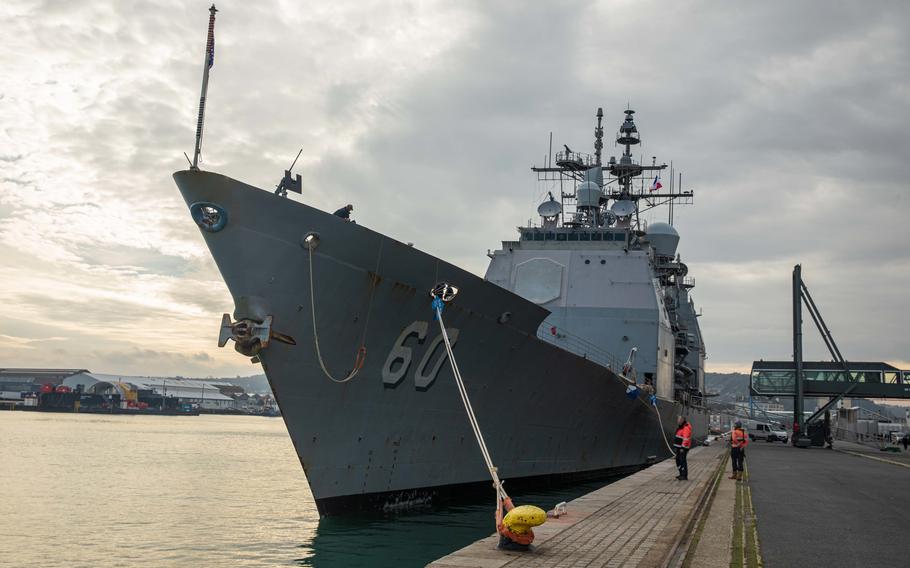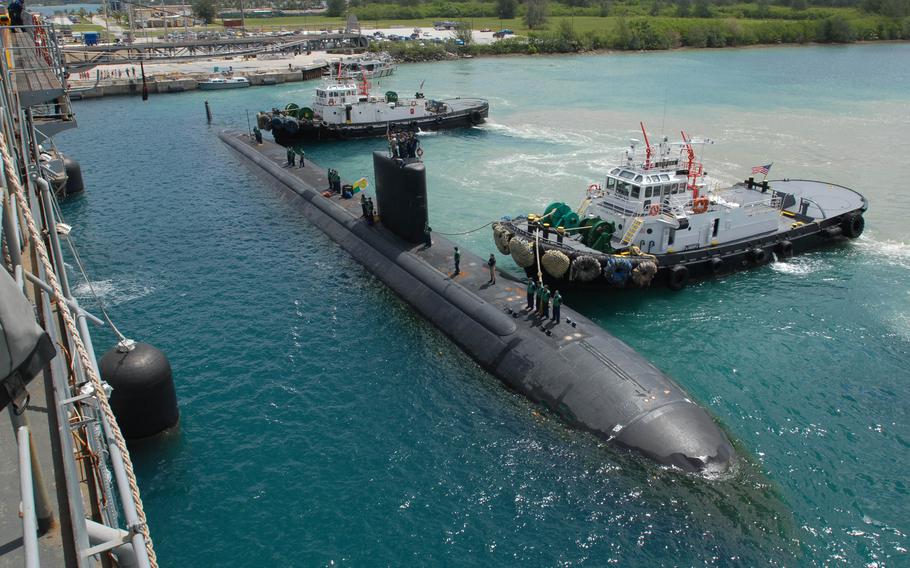
USS Normandy, a Ticonderoga-class, guided-missile cruiser, arrives at Cherbourg, France, in November 2022. (Malachi Lakey/U.S. Navy)
The Navy’s plan to buy fewer ships while accelerating early retirements for others across the fleet has drawn the opening salvos of criticism from at least one member of Congress.
The more than $250 billion budget proposed for fiscal 2025 for the Navy and Marine Corps includes fewer purchases of Virginia-class attack submarines and F-35 Lightning II fighter variants. The Navy’s plan would fund long-term projects such as a second Columbia-class, ballistic-missile submarine and two more Ford-class aircraft carriers.
The Navy also seeks to get rid of 19 ships, including 10 before reaching their expected service life, a move Congress has been reluctant to support in recent years.
Rep. Joe Courtney, D-Conn., said last week that the Navy’s decision to buy one new Virginia-class attack submarine instead of two “makes no sense” as the U.S. faces a rapidly expanding Chinese navy, which has set a target size of 440 ships by 2030. The U.S. Navy has 291 ships.
“We have an urgent need to expand the submarine fleet,” said Courtney, whose district includes Naval Submarine Base New London in Groton. “This is not good budgeting or good planning.”
The House and Senate will begin holding hearings this week on the Pentagon’s proposed budget, but some criticism has already emerged since the spending plan was publicly released March 11. Sen. Angus King, I-Maine, expressed concern almost two weeks ago about an “icebreaker gap” with the Russians and allowing them to outpace the Navy with ships that can operate in the Arctic Ocean.
Courtney, whose district also includes the General Dynamics Electric Boat facility where half of the Virginia-class attack submarines are built, is the top Democrat on the House Armed Services Committee’s subpanel on seapower and projection forces. He plans to raise the issue of the submarines at House Armed Services Committee hearings this week and a fuller examination at a subcommittee hearing to be scheduled later.
The Navy’s budget plan said fiscal uncertainty, new congressional spending caps and a lag in construction pace at shipyards required a pause in some new procurement, and the early ship retirements will allow for more budget flexibility.
“This is a return-on-investment decision — ship by ship, class by class — based on material condition, life remaining, cost and time to upgrade, and net warfighting value,” said Lt. j.g. Luke Bienstock, a Navy spokesman.
Courtney said Congress has backed the construction of a new generation of submarines and aircraft carriers despite restraints put on federal budgets.
“Citing downward budget pressure is really lousy justification,” he said.
King said he has been calling for more icebreakers since 2015 as the Arctic has become a growing area of military and commercial competition between NATO and Russia, with China also increasing its shipping presence.
The Department of Homeland Security reported in October 2023 that Russia has about 40 operational icebreakers, though most are assigned to specific Russian northern port operations. The United States has only one operational icebreaker.
King said the icebreakers allowed Russian shipping more options to slice through thin ice, while the United States was left “not having a road to get where you need to get.”
Air Force Gen. Gregory Guillott, the new commander of U.S. Northern Command, told King at the hearing that while the U.S. Coast Guard planned to increase the number of icebreakers, the shortage of U.S. capabilities would remain acute.
“We will be severely outnumbered,” he said. “That does limit our freedom of maneuver in that region.”

USS Topeka, a Los Angeles-class attack submarine, shown in 2012. (David Krigbaum/U.S. Navy)
In the fiscal 2025 budget plan, the Navy is requesting one Virginia-class submarine, two Arleigh Burke-class destroyers, one Constellation-class guided-missile frigate, one San Antonio-class amphibious transport dock and one medium landing ship.
The proposed budget also directs funds from buying a second Virginia-class submarine to be spent instead upgrading the supply-chain infrastructure for the submarine program. More than 15,000 companies in all 50 states are involved in some portion of building Navy submarines.
Funding for the largest fleet purchases is spread throughout several years. The Navy wants incremental budget money to continue building the third and fourth Ford-class carriers — USS Enterprise and USS Doris Miller. Both will enter service in the 2030s.
The Navy also requested continued funding for what service leaders called their “top priority” in budget documents — funding for the USS Wisconsin, the second Columbia-class ballistic-missile submarine. The first, USS District of Columbia, is scheduled for a delivery date in October 2027. The Wisconsin would be delivered in April 2030.
Construction delays on USS District of Columbia have required the Navy to look at extending the life of older Ohio-class, ballistic-missile submarines. The Navy has also converted some early Virginia-class submarines to launch nuclear weapons as a stop-gap measure to maintain the naval portion of the “nuclear triad” that includes land-based intercontinental ballistic missiles and Air Force bombers.
“The Navy and the shipbuilders are continuing to take immediate and aggressive action to address key performance drivers” to keep USS District of Columbia from falling further behind schedule, Bienstock said.
To stretch costs, the Navy curtailed its planned purchase of F-35 fighter jets. The budget requests 13 F-35C Lightning II carrier-launched jets instead of earlier projections of 19 aircraft. The jets would be split between Navy and Marine squadrons. The Navy also cut its purchase of F-35B Lighting II variants with vertical take-off and landing capability for the Marine Corps, reducing the request for 19 jets to 13.
Three Los Angeles-class submarines, two Ticonderoga-class cruisers and four mine-detection ships have passed their expected service life dates and are among the 19 ships targeted for retirement by the Navy.
However, the other 10 that the Navy wants to remove from the fleet are still short of retirement age. The gaps range from one and two years for two more Ticonderoga-class cruisers to 29 years for USNS John Glenn, an expeditionary land dock vessel only 11 years into its expected 40-year service.
The Navy said the John Glenn, which was designed as a base to launch up to three large air-cushioned assault ships, doesn’t match up with Navy plans that increasingly focused on regional conflicts against “near-peer” adversaries such as Russia and China.
Other early retirements target littoral combat ships and expeditionary light transports designed for interdiction and counter-insurgency action. All have served less than half their designed lifespan.
Congress has blocked earlier attempts to retire ships ahead of schedule. The Navy increased its requests for early retirements in fiscal 2020, pivoting from regional conflicts to global ones.
“The central theme of all this guidance is the return to great-power competition,” Rear Adm. Randy Crites, the Navy’s deputy assistant secretary for budget, said during a 2020 briefing.
Crites said ships such as the littoral combat ships no longer fit into the Navy’s strategy as they had less than a decade before.
“In great-power competition, they are less important,” he said.
The Navy also sought to retire the Nimitz-class aircraft carrier USS Harry S. Truman that year to allow budget flexibility for other priorities.
Congress blocked the Truman retirement and has stopped most of the Navy’s plans to retire ships before their expected service dates. In fiscal 2023, the Navy sought to retire 16 ships early, but Congress only approved six.
Navy Undersecretary Erik Raven called for cuts last year, saying the Navy needed to be allowed to decide how best to shape the fleet.
“We have sailors and Marines who are serving on these ships. We think that getting them matched up with the right platforms is the way to go,” he said.
In the fiscal 2025 budget, five of the 10 ships that the Navy is looking to retire ahead of their lifespan deadline have been on earlier budget requests that Congress denied.
The ships on the 2025 Navy retirement list include:
• Three Los Angeles-class, nuclear-powered attack submarines: USS Helena, USS Pasadena and USS Topeka. All have surpassed their 33-year estimated service life. If retired, more than half of the 62 Los Angeles-class submarines commissioned since 1976 will have retired. The last of the class, USS Cheyenne, was commissioned in 1996. Their place is being taken by the three Seawolf attack submarines and the Virginia-class, fast-attack submarines.
• Four Ticonderoga-class cruisers: USS Philippine Sea and USS Normandy are at about their 35-year estimated service life. The USS Shiloh and USS Erie have two and three years left, respectively. The Navy wants to retire all four in 2025. In 2024, Congress blocked the Navy’s proposal to retire the USS Shiloh.
• Two Independence-class littoral combat ships. The 10-year-old USS Montgomery and 11-year-old USS Jackson are less than halfway through their projected 25-year service life. The Navy has sought to dispose of the ships because of maintenance problems and the need for costly upgrades, and what service leaders said is a mismatch with current Navy needs.
• Four mine countermeasures ships: USS Sentry, USS Devastator, USS Gladiator and USS Dextrous are all beyond their estimated service life. Used extensively during Operation Desert Storm, all four operate from a Navy facility in Bahrain.
• Four expeditionary light transports: The transports have lightweight aluminum hulls and can operate at up to 43 knots in shallow waters. Of the four, the USNS Spearhead has a damaged bow, while USNS Fall River and USNS Choctaw County are listed as inactive. The fourth ship is the USNS Millinocket. All are at about the halfway point of their projected 20-year service life.
• Two seagoing docks: The USNS John Glenn, an expeditionary landing dock, is listed as inactive in San Diego. The Navy sought to retire the ship in 2023, but Congress did not approve the action. The USS Germantown is the second of the Whidbey Island-class landing dock ships. It took part in Operation Desert Storm and saw action in the invasion of Iraq. The Navy sought to retire the ship in the fiscal 2024 budget with two years left on its service life. The Navy wants to decommission the vessel again in 2025.